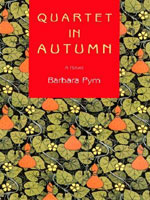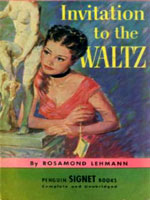Overlooked Women Novelists
by Andrew Corbin, Acquisitions and Reference Librarian
This article originally appeared in the "Off the Shelf: A Reader's Review" column in the Library's Spring 2010 Features Newsletter.
"This is an important book, the critic assumes, because it deals with war. This is an insignificant book because it deals with the feelings of women in a drawing-room. A scene in a battle-field is more important than a scene in a shop - everywhere and much more subtly the difference of value persists." - Virginia Woolf, A Room of One's Own
In the eighty-one years since Virginia Woolf published A Room of One's Own, change has come slowly in terms of how women's literature is viewed. With some notable exceptions, unless they tackle the "Big Issues," women writers are either ignored or dismissed as lightweight. This is particularly true of the so-called "domestic novel," a term typically applied to novels written by English women which are largely concerned, as novelist Amanda Craig notes, with "love, marriage, and property." In recent years, however, the critical tide has begun to turn - women's fiction and the domestic novel are finally being taken seriously as literature in their own right. What follows is a brief introduction to three women's novelists who deserve wider recognition: Barbara Pym, Elizabeth Taylor, and Rosamond Lehmann.
Barbara Pym (1913-1980)

As a chronicler of quiet, unassuming lives, Barbara Pym has no equal. Peopled largely by Anglican clergymen and their wives, minor academics, and unattached women of all ages unfeelingly called "spinsters," Pym's novels are hymns to humility. They are also eloquent testimonies to the power of everyday things, a cup of tea perhaps, or an evening prayer service, to comfort and console the lonely and the loveless. But while the unconverted dismiss her as 'naive" or "trivial," her many devoted readers see in her a writer unafraid to find the raw material of art in the commonplace, and a shrewd yet compassionate observer of human nature with a gentle sense of humor. Anyone tempted to read Barbara Pym should pick up her 1977 novel Quartet in Autumn, which was shortlisted for the Booker Prize. What begins as a seemingly simple story about four office workers on the verge of retirement slowly becomes a masterful tragicomedy about the devastating effects of isolation on the elderly and the stubborn resilience of the human spirit.
Elizabeth Taylor (1912-1975)
Although she achieved some modest commercial and critical success early in her career, Elizabeth Taylor is largely unknown today. In the words of Kingsley Amis, "she never received her due as one of the best English novelists born in this century." This despite the fact that she left behind a body of work which abundantly demonstrates her mastery of a particular kind of writing - sharply observed, ironic, and emotionally rich stories about middle-class English life. Perhaps it was the unfashionable aura of gentility that permeates her writing or her pathological shyness when it came to discussing her work publicly, or simply that she shared a name with one of the most famous film stars of the twentieth century. Whatever the reason, Taylor's writing has rarely been given the serious consideration it deserves. Readers should start with Mrs. Palfrey at the Claremont, a surprisingly comic and moving novel about life at a London residential hotel for the elderly.
Rosamond Lehman (1901-1990)
Of all the authors marginalized as writers of "women's fiction," Rosamond Lehmann is the one whose neglect is perhaps most surprising. Her first novel, 1927's Dusty Answer, was a publishing sensation. It brought the 26-year-old Lehmann considerable attention and established her as an astute observer of women's lives in England during the years between the two world wars. In terms of portraying women torn between the desire for independence and the need for love, Lehmann remains peerless. Her masterpiece is her fourth novel, published in 1936. In many ways the literary progenitor of novels like Helen Fielding's Bridget Jones' Diary, The Weather in the Streets is the strikingly modern story of an intensely romantic young woman who, while living a bohemian life in 1930's London, falls in love with a married man. What in the hands of a lesser writer could easily have devolved into a maudlin soap opera is transformed by Lehmann's consummate artistry into a haunting study of self-deception and self-discovery, as well a wonderfully evocative depiction of the agonies and ecstasies of love.
Further Reading: Non-Fiction
- Beauman, Nicola. The Other Elizabeth Taylor, 2009.
- Beauman, Nicola. A Very Great Profession, 2008.
- Craig, Amanda.In Defense of the Domestic Novel
- Hastings, Selina.Rosamond Lehmann, 2002.
- Holt, Hazel. A Lot to Ask: A Life of Barbara Pym, 1991.
- Humble, Nicola.The Feminine Middlebrow Novel, 1920s to 1950s: Class, Domesticity, and Bohemianism, 2004. , 1977.
- Woolf, Virginia. A Room of One's Own, 1929.
Further Reading: Other Recommended Novels
- Jenkins, Elizabeth.The Tortoise and the Hare, 1954.
- Laski, Margharita.The Village, 1951.
- Sharp, Margery.The Eye of Love, 1957.
- Strachey, Julia. Cheerful Weather for the Wedding, 1932.
- Whipple, Dorothy. Someone at a Distance, 1953.


